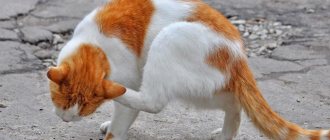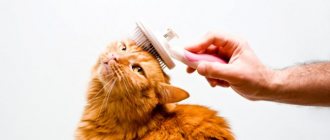Symptoms of otitis Causes of otitis in cats Parasitic otitis Bacterial otitis Immune-related otitis Otitis caused by the presence of a tumor or foreign body Diagnosis of otitis Treatment of otitis in cats Otitis in cats is an inflammation of the ear canal.
According to the anatomical principle, external, middle and internal otitis are distinguished - depending on which ear was affected - anatomically, the outer, middle and inner ears of a cat are distinguished. The outer ear includes the pinna and the external auditory canal, where the cerumen glands are located. A cat's middle ear includes the eardrum and the auditory ossicles (hammer, incus, and stapes). The inner ear is an auditory labyrinth, and the organ of Corti, which directly transmits sounds, is also where the vestibular apparatus is located, so internal otitis is often accompanied by disturbances in its functioning (for example, a cat walks with its head tilted to one side).
According to the etiological principle, that is, the reason that caused otitis media in a cat, the following types are distinguished:
- parasitic otitis,
- microbial (bacterial) otitis,
- immune-related (allergic, atopic, autoimmune),
- otitis caused by the presence of a tumor in the ear canal or a foreign body, otitis due to endocrinopathies,
- Chronic viral infections in cats, leading to a decrease in general and local immunity, also contribute to the development of otitis media.
Otitis is accompanied by discharge from the ear - exudate. The nature of the exudate may be different for different etiological reasons, depending on what caused the development of otitis media:
- Dry dark brown discharge is characteristic of otodectosis
- Liquid brown - for bacteria and fungi
- Purulent yellow - gram-negative microflora
- Gray-yellow curdled exudate - fungal pathologies
- Yellow-brown waxy - seborrheic and ceruminous otitis
Symptoms of otitis media
Frequent accompaniments of otitis media are pain, itching, redness of the skin on the inner surface of the ear, and increased discharge from the ears. A cat can often scratch its ear, until bald patches and wounds appear on the auricle, and does not allow the ear to be touched. If a cat shakes its head, this indicates discomfort in the ear canal area.
“Dirty” ears, that is, increased secretion of exudate, is also most often a symptom of otitis media. Normally, in cats, discharge from the ears practically does not accumulate, the auricle is clean. If you often need to clean your cat’s ears, you should consult a dermatologist to determine the cause of such an increased amount of exudate.
Symptoms
You can suspect a cat has otitis media by its behavior. Among the signs:
- Lethargy;
- The sore ear is bent;
- Loss of appetite;
- Pain in the ear makes the cat behave strangely, for example, when there is a shooting in the ear, the cat gets scared and jumps up;
- Discharge of pus from the ear; when pressed, a characteristic squelching sound occurs;
- Loss of coordination: drunken gait, the cat cannot jump or walk normally;
- Sagging of the lip and eyelid on the side of the inflamed ear;
- Tilt of the head to the side, shaking the head;
- Constant drowsiness, attempts to hide in secluded places.
- Your pet may exhibit sensitivity to light and sound.
With otitis externa, when examining the ears, you may notice redness, discharge from the ear, sores and scratching. The cat may rub its head on the furniture and scratch furiously.
Parasitic otitis
The most common cause of the development of both parasitic otitis media and otitis media in general in cats are mites of the genus Otodectes. The disease they cause is called otodectosis. Signs of this disease include increased dark brown, dry discharge from the ears, as well as itching. Often, bacterial otitis caused by secondary microflora (bacteria and/or fungi) develops against the background of otodectosis. Otodectosis is contagious and can be transmitted from cat to cat or from cat to dog and vice versa. This disease does not pose any danger to people.
Risk factors
Be sure to contact your veterinarian if your cat shows signs of otitis media. When making a diagnosis, the doctor takes into account the following factors:
— Animal nutrition (possibility of allergic reactions); — The shape of the ears and the thickness of the hair on them (in lop-eared kittens, more favorable conditions are created in the ears for the development of pathogens); — Treatment carried out prior to the disease; — Treatment against parasites; — Frequency of bathing (possible exposure to water); — Proper ear cleaning.
Bacterial otitis
Bacterial or microbial otitis is almost always secondary, due to allergies or injuries to the ear cavity. One of the fairly common causes of ear injury in cats is improper cleaning using cotton swabs. Cats have a completely different structure of the auricle; when using cotton swabs, the ear canal is not cleaned due to its anatomical features. The ear canal is curved, so when you try to clean the ear with a cotton swab, all the secretions are compacted, their outflow is disrupted, and this provokes the so-called congestive otitis media. Active cleaning with a cotton swab often causes injuries; cotton fibers remain in the ear, which can also cause inflammation.
Ceruminous otitis media develops against the background of irritation of the skin of the external auditory canal. It is characterized by increased release of sulfur. Frequent ear cleaning, especially using cotton swabs, also contributes to its development. The more the wall of the external auditory canal is irritated, the more the glands work.
Causes
Various reasons can contribute to the development of the disease. Kittens and cats often suffer from otodectosis; this is a contagious disease caused by ear mites Otodectes cynotis. They are transmitted by contact with a sick animal and can cause otitis media.
In addition, pathology can result from:
- Bacteria: staphylococcus, streptococcus, E. coli;
- Fungi;
- Viruses;
- Allergy and autoimmune processes;
- Hormonal disorders.
In elderly pets, when examining the auricle, various types of neoplasms and polyps can be found, which also contribute to the development of the disease.
The cause of inflammation can be injury, structural features of the pet's ear, or a foreign object entering the ear.
Immune-related otitis
Otitis can occur against the background of various types of allergies. Most often, as a result of an allergy to flea saliva, this is also how atopic allergies (to environmental factors, such as dust) or food allergies manifest themselves.
There is such a disease as proliferative and necrotizing otitis media in kittens. It develops only in kittens and is manifested by erosions and ulcers on the skin of the ear canal and the appearance of areas of necrotic tissue. As a rule, with this disease there is no pain syndrome and the kittens’ ears do not bother them at all. The disease is not contagious. It is easily treated with immunosuppressants, as it is immune-mediated.
Also, otitis in cats develops against the background of an autoimmune disease such as pemphigus foliaceus. In this case, not only the ears are most often affected, but also the scalp and other areas.
Causes of the disease
Like any other disease, otitis media must have its own causes:
a) parasites – waste products of insects cause irritation and inflammation of the ear; b) foreign bodies - they get during games and walks in the grass, and it can also be water that gets in while swimming; c) skin atopy is a chronic disease caused by allergies or hereditary predisposition.
Most often, otitis media occurs due to parasites and poor nutrition, as well as improper care of the pet’s ears by the owner.
Otitis caused by the presence of a neoplasm or foreign body
Otitis develops when foreign bodies enter the ear. Often the cause is the same cotton swabs, which break off or cotton flakes separate and get into the ear canal. Also, the cause may be grass seeds - this is typical for cats walking in the country.
It is not uncommon for cats to develop neoplasms of the ceruminous glands (glands that secrete sulfur). Such tumors are called cerumin. If the tumor opens and becomes infected, then purulent, and sometimes purulent discharge mixed with blood, can be observed from the ears. In such cases, it is necessary to perform otoscopy to visualize the tumor.
.
Diagnosis of the disease
If contacted in a timely manner, the specialist makes a diagnosis based on the owner’s observations, general examination and otoscopy. With a mild form of the pathology, this is enough to establish the cause and prescribe appropriate medications.
Otoscopy is an examination of the ear canal using a special device. The study allows you to find out whether the eardrum is intact, whether there are foreign bodies in the ear, or determine the presence of a tumor.
Otoscopy is performed after anesthesia.
Otoscopy is an examination of the animal's ear using a special device.
If the middle ear is affected, a cytological smear is necessary to determine the true causes of inflammation. If demodicosis is suspected, trichoscopy can be performed - examination of hairs and particles of the epidermis. In very advanced cases, video-otoscopy, radiography or MRI may be required. The last type of research is more informative.
DIAGNOSIS OF OTITIS
There are many causes of otitis, and treatment will vary significantly, so it is necessary to determine what exactly caused the inflammation. This can only be done by a dermatologist; it is impossible to do this at home - you need a laboratory.
The primary diagnosis of otitis media includes:
- inspection,
- otoscopy,
- taking a cytological smear from the external auditory canal,
- scraping and trichoscopy in case of demodicosis (rare).
Additional methods are used to diagnose neoplasms or otitis media:
- video otoscopy under anesthesia,
- radiography,
- MRI/CT examination.
In some cases, it is necessary to take a bacterial culture from the ear to determine sensitive flora.
Otitis media in cats can develop as a primary disease, unlike dogs, in which otitis media most often develops against the background of external otitis media when the eardrum is perforated; in cats, the integrity of the eardrum does not exclude otitis media.
The causes of otitis media in cats include: viruses, mycoplasmas, bacterial infections from the respiratory tract, nasopharyngeal polyps. Additional diagnostics are required to determine the causes.
Symptoms of otitis media include:
- pain,
- tilting the head towards the affected ear,
- neurological symptoms, as the ocular and facial nerves may be affected.
Video of an ear examination of a cat with otitis media.
Types of otitis
Otitis is a group of diseases that combine diseases associated with inflammatory processes in the ears. Depending on the course of the disease, they can be acute or chronic. The ear is divided into three parts - outer, middle and inner. And depending on the place of development of the inflammatory process, the disease occurs:
1) External form - localized in the superficial parts of the ear. Easily cured. 2) Medium form - descends into the lower parts of the ear, affecting the eardrum. Timely treatment starts guarantees a favorable outcome, otherwise it can take a chronic form. 3) Internal form - extends to the membrane and beyond. A severe form of the disease with purulent lesions, without treatment, leads to hearing loss, the development of meningitis and sepsis.
Otitis media in a cat develops in one or both ears.
Treatment of otitis media in cats
Treatment comes down to eliminating the etiological factor (antiparasitic drugs, removal of polyp/tumor, immunosuppressants for autoimmune diseases), as well as eliminating secondary microflora and hygiene of the external auditory canal. However, a treatment method that can eliminate the cause of otitis media can be chosen only after consultation with a doctor, who will determine this cause. It is highly not recommended to use any drops at home before visiting a doctor, even as recommended by a veterinary pharmacy - if the integrity of the eardrum is damaged, this will lead to very severe deviations. The doctor will determine the cause of otitis in the cat and select a treatment regimen that can be carried out at home. To sanitize the external auditory canal, you can use warm saline solution or special lotions or chlorhexidine bigluconate 0.05%. Lotions and chlorhexidine can only be used on the recommendation of the attending physician, since if the eardrum is perforated, they also cannot be used. Different lotions have different effects (antiseptic, sulfur dissolution, drying effect, etc.).
The article has already repeatedly mentioned how you can’t clean a cat’s ears—you can’t use cotton swabs or just cotton wool. To properly sanitize the ear canal, you need to completely fill the ear with the solution, massage the base of the auricle, then let the cat shake its head. Remove any remaining dirt from the surface of the ear with a bandage, but not with cotton wool or cotton swabs, since the microvilli of cotton wool further irritate the skin of the inflamed ear canal. You need to treat your ears several times until the dirt stops coming out. This procedure must be repeated 1-2 times a week, in especially severe cases 3-4 times.
(c) Veterinary center for the treatment and rehabilitation of animals “Zoostatus”. Varshavskoe highway, 125 building 1. tel. 8 (499) 372-27-37
Veterinarian help
After the veterinarian has determined the causes of the cat's anxiety and made a diagnosis, he prescribes treatment. First of all, with the help of medications, the veterinarian relieves ear pain and itching in the cat. If there is discharge, dirt, or excess wax in the ears, then clean them. It is performed in the following sequence:
- The auricle is turned outward to provide access to the ear canal.
- The fur on the inside of the ear is carefully trimmed.
- A cotton swab is dipped in oil and the plaque is removed within sight.
- The second ear is treated in the same sequence.
For external otitis in a cat, the veterinarian treats the damaged surface and instills liquid medicine, after which he gently massages the auricle to evenly distribute the solution. In case of deep purulent otitis media, the cat's eardrum is pierced to remove pus from the distant parts of the ear. After deep cleaning, the ears are treated with systemic antibiotics. Owners of furry patients are advised to take note of the veterinarian's advice from the following video:
global $ads_google; //data-ad-slot=”2475549904″ $ads_google = empty($ads_google) ? false : true; ?> if ($ads_google == false) {?>
$ads_google = true; ?> } ?>
SYMPTOMATICS OF THE DISEASE
An attentive owner will always notice the first signs of otitis media.
Here is a typical sequence of symptoms:
- First, you will notice redness and irritation on the skin of the animal's ears.
- The cat constantly rubs its ears with its paws and presses them to its head.
- After some time, she begins to feel pain, it can be “shooting”, when the animal suddenly screams, begins to worry and look around in fear.
- If the pain does not go away, then the cat does not allow itself to be stroked on the head, turns away or lies down with the sore ear on a hard surface.
If at these stages you have not taken any measures to neutralize inflammatory processes, the symptoms of the disease become more and more pronounced. So, ulcers, grooves, pimples begin to appear on the skin of the cat’s ears, the animal tears its ears until they bleed, damage to the facial nerve is possible, when the cat’s lip or eyelid sag (partial paralysis), pus appears from the ears, and an unpleasant odor is heard from there. In some cases, the body temperature rises, the cat does not eat anything, avoids communication, does not play, constantly meows, is irritated and angry.
Treatment
With otodectosis, you need to spend more time caring for your ears. Contaminated areas must be cleaned daily of parasite metabolic products. Next, the hearing organs are treated with a medicinal composition (for example, Ectodex or Mycodemocid). Preparations for combating ear mites in animals are available in the form of suspensions, aerosols, and drops. Both ears are treated with an acaricidal agent, even if one of them looks completely healthy. If a bacterial infection occurs, the doctor additionally prescribes a course of antibiotics.
Otitis requires a slightly different approach. The ears are washed to remove accumulated pus and plaque. To do this, dip a cotton pad in hydrogen peroxide, furatsilin solution or boric acid. The remaining moisture after washing is soaked with a dry cloth or piece of cotton wool. Both ears are treated with medication prescribed by the veterinarian. If the disease is accompanied by severe pain, a novocaine blockade is first performed.
A course of antibiotics is prescribed to suppress bacteria. The duration of therapy usually does not exceed a week.
Folk remedies for otitis media
Use folk remedies only as an auxiliary treatment. They produce a weak therapeutic effect. The safest is green tea. Strain it through cheesecloth and wipe the cat's ears. Tea has an acaricidal and disinfectant effect.
The same effect is obtained from collecting herbs from St. John's wort, lavender, medicinal chamomile, birch leaves, and string . However, do not use traditional methods of therapy. They can reduce the effectiveness of drugs and cause negative reactions in the pet’s body.
Prevention
In order to minimize the likelihood of otitis media, the following preventive measures must be observed:
- Clean your ears only when they become dirty. If you are unsure whether to clean, consult a professional. Cleaning your ears too often can lead to ear infections;
- To clean ears, use specialized hygienic solutions intended for animals. Should be used according to the instructions, using the optimal amount of lotion;
- Do not use cotton swabs for cleaning. Gently clean only the visible parts of the ear using a cotton pad;
- Regularly treat your pet for ectoparasites. This will eliminate parasitic and allergic factors.











